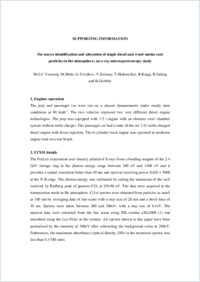On source identification and alteration of single diesel and wood smoke soot particles in the atmosphere; an X-ray microspectroscopy study
- Vernooij, Martine G. C. Empa, Swiss Federal Laboratories for Materials Testing and Research, Thun, Switzerland
- Mohr, M. Empa, Swiss Federal Laboratories for Materials Testing and Research, Thun, Switzerland
- Tzvetkov, G. Paul Scherrer Institut, Villingen, Switzerland
- Zelenay, V. Paul Scherrer Institut, Villingen, Switzerland
- Huthwelker, T. Paul Scherrer Institut, Villingen, Switzerland
- Kaegi, R. EAWAG, Swiss Federal Institute of Aquatic Science and Technology, Dübendorf, Switzerland
- Gehrig, R. Empa, Swiss Federal Laboratories for Materials Testing and Research, Thun, Switzerland
- Grobéty, Bernard University of Fribourg, Environmental Mineralogy, Switzerland
-
01.06.2009
Published in:
- Environmental Science and Technology. - 2009, vol. 43, no. 14, p. 5339–5344
English
Diesel and wood combustion are major sources of carbonaceous particles in the atmosphere. It is very hard to distinguish between the two sources by looking at soot particle morphology, but clear differences in the chemical structure of single particles are revealed by C(1s) NEXAFS (near edge X-ray absorption fine structure) microspectroscopy. Soot from diesel combustion has a dominant spectral signature at ~285 eV from aromatic π-bonds, whereas soot from wood combustion has the strongest signature at ~287 eV from phenolic carbon bonds. To investigate if it is possible to use these signatures for source apportionment purposes, we collected atmospheric samples with either diesel or wood combustion as a dominant particle source. No spectra obtained from the atmospheric particles completely matched the emission spectra. Especially particles from the wood dominated location underwent large modifications; the phenolic spectral signature at 287 eV is greatly suppressed and surpassed by the peak attributed to the aromatic carbon groups at ~285 eV. Comparison with spectra from diesel soot samples experimentally aged with ozone show that very fast modification of the carbon structure of soot particles occurs as soon as they enter the atmosphere. Source attribution of single soot particles with microspectroscopy is thus hardly possible, but NEXAFS remains a powerful tool to study aging effects.
- Faculty
- Faculté des sciences et de médecine
- Department
- Département de Géosciences
- Language
-
- English
- Classification
- Meteorology, climatology
- License
-
License undefined
- Identifiers
-
- RERO DOC 13177
- DOI 10.1021/es800773h
- Persistent URL
- https://folia.unifr.ch/unifr/documents/301288
Other files
Statistics
Document views: 138
File downloads:
- pdf: 277
- Supplementary material: 153

